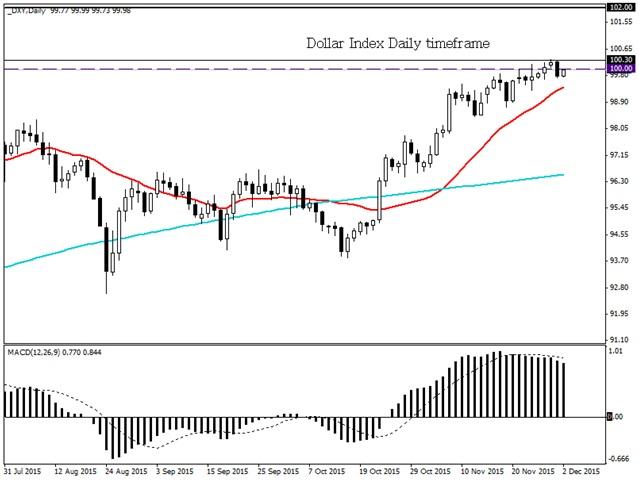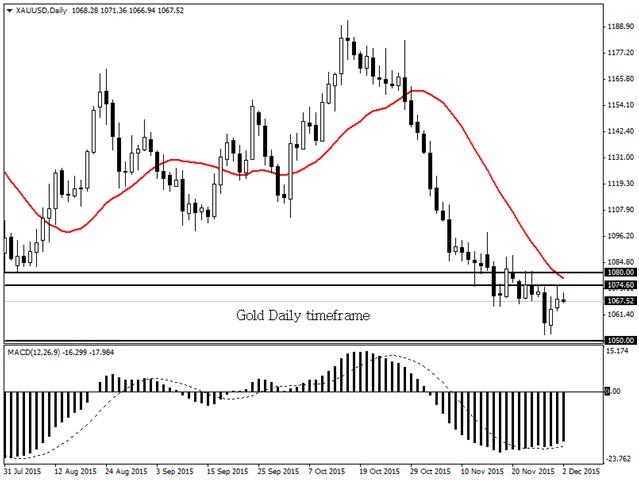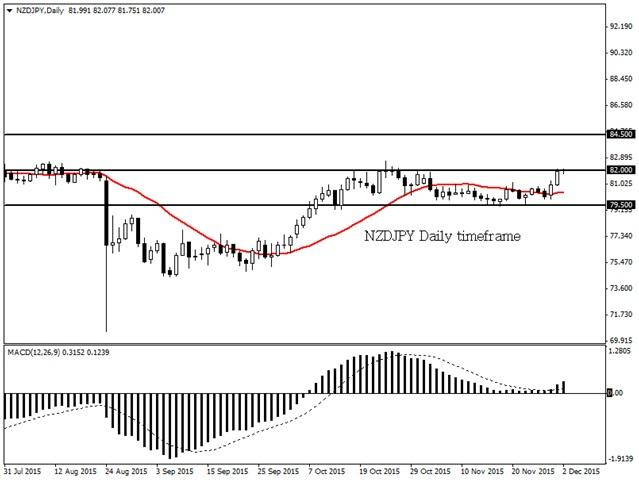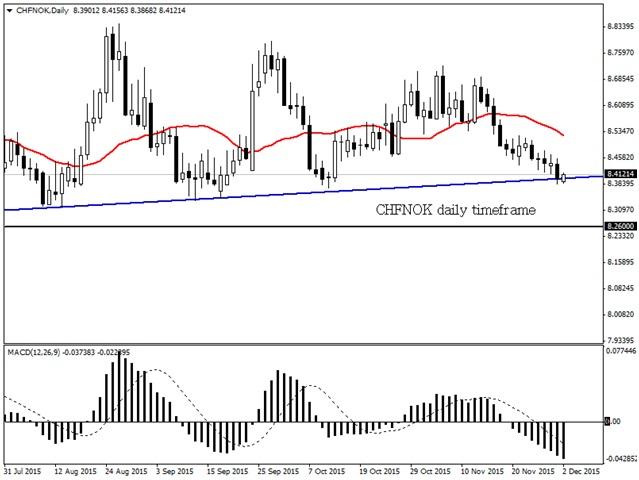Sentiment towards the USD received a swift blow following the unexpected contraction in the US manufacturing sector of 48.6, its lowest level since the end of the recession almost 6 years ago.Although it was cited that the catalytic combination of weak global demand and a strengthening Dollar punished the US manufacturing sector, investor anxiety has exposed the USD to weakness as concernsrekindle that this may sabotage the Fed’s decision to raise US interest rates in December. These fears are understandable because history shows that the Fed has not raised interest rates while the ISM manufacturing index has been below 50.0 since the mid-1990’s, and as such this reinforces the gravity of Friday’ jobs report. However, the Fed futures still illustrates a 75% likelihood of a US interest rate hike in December and a solid NFP reading for November should fortify these expectations and seal the deal.
Today the focus will be turned towards both the ADP Non-farm Employment change and the speech from Fed Chair Janet Yellen, in which investors will be seeking additional clarity around the subject of a December US interest rate hike. If the ADP Non-farm Employment change exceeds expectations, this may add to the previous results which have provided a compelling case for the Fed to move forward with raising US rate before year-end.
Dollar Index holds ground
The Dollar Index experienced a sharp decline from its weekly high of 100.300 as investors pondered the impact of the contraction in the US manufacturing sector. Despite this slight setback, the sentiment still remains bullish towards the Dollar and with data in November reinforcing optimism around a US interest rate hike in December, as well as other central banks still threatening further easing; this may provide the opportunity for the Dollar Index to appreciate higher in the future. The previous resistance at 100 may form into a dynamic support which should attract buyers who see a possibility of prices trading back towards the March 2003 highs at 102.
GBPUSD under pressure
Sentiment towards the GBPUSD continues to erode, even after a new a low was hit on Monday when the currency pair dropped below 1.500 for the first time since April and fell to fresh seven-month lows at 1.4993. The pair was exposed to downside pressures on Tuesday after a declining manufacturing PMI of 52.7 which signaled a slowdown in the month of November. Whilst part of the reason for the decline in the GBPUSD has been due to the resumption of USD strength through the currency markets, the slowdown in Britain’s manufacturing industry has added to the renewed concerns over the potential slowdown in economic momentum in the UK economy which has left the Sterling vulnerable.
The pound may continue to suffer from the BoE’s clear reluctance to begin raising UK interest rates, whilst the non-existent inflation growth in the UK economy, which has diluted some pressures from the central bank to act, has weighed heavily on investor sentiment. Today’s focus for the UK economy will be directed towards both the construction PMI and the parliamentary vote for airstrikes in Syria which may reduce investor attraction towards the Sterling, resulting in a further decline within the GBPUSD.
From a technical standpoint, the GBPUSD remains depressed, bearish and further GBP weakness may send the pair towards to the 1.5100 support.
GOLD gearing for a further decline
Gold, still a victim of the ongoing Dollar appreciation, attempted to gain upside momentum on Tuesday with prices hitting a weekly around 1074.60. This appreciation was short lived as the continually downwards pressures faced from the increasing optimism over an increase in US interest rates this year has dragged prices back down in Wednesday’s trading session. This precious metal remains fundamentally bearish and the array of robust economic releases from the United States in November has encouraged heavy selling momentum throughout metal trading. With Gold remaining completely dictated by US interest rate expectations, additional positive economic releases from the States which reinforce the possibility of a December rate hike may act as a catalyst for prices to decline towards $1050.
From a technical standpoint Gold, is heavily bearish on the daily timeframe as there have been consistent lower lows and lower highs. Prices are trading below the daily 20 SMA and the MACD has also crossed to the downside. The previous support around $1080 may act a dynamic resistance which should encourage sellers to send prices back towards $1050.
NZDJPY
The NZDJPY is technically bullish on the daily timeframe. Prices are trading above the daily 20 SMA and the MACD has also crossed to the upside. A breakout above the 82.00 resistance may open a path to the next relevant resistance based at 84.50.
CHFNOK
The CHFNOK is technically bearish on the daily timeframe. Prices are trading below the daily 20 SMA and the MACD has crossed to the downside. Prices may decline towards the 8.2600 level if the trend line received a decisive breakdown.
Disclaimer:This written/visual material is comprised of personal opinions and ideas. The content should not be construed as containing any type of investment advice and/or a solicitation for any transactions. It does not imply an obligation to purchase investment services, nor does it guarantee or predict future performance. FXTM, its affiliates, agents, directors, officers or employees do not guarantee the accuracy, validity, timeliness or completeness of any information or data made available and assume no liability for any loss arising from any investment based on the same.
Risk Warning: CFDs are complex instruments and come with a high risk of losing money rapidly due to leverage. 90% of retail investor accounts lose money when trading CFDs with this provider. You should consider whether you understand how CFDs work and whether you can afford to take the high risk of losing your money.
Recommended Content
Editors’ Picks
EUR/USD pares gains to near 1.0850, focus shifts to US ISM PMI

EUR/USD is paring back gains to trade near 1.0850 in the European morning on Monday. Softer US monthly Core PCE inflation data and hotter-than-expected Eurozone HICP inflation data help the pair to stay afloat amid a better market mood. US ISM PMI holds the key.
GBP/USD consolidates around mid-1.2700s, downside seems cushioned amid softer USD

The GBP/USD pair kicks off the new week on a subdued note and oscillates in a narrow band, around mid-1.2700s during the Asian session. The downside, meanwhile, remains cushioned in the wake of a modest US Dollar weakness, weighed down by signs of easing inflationary pressures in the United States.
Gold focuses on daily close below $2,330 and US ISM PMI

Gold price is licking its wounds while trading close to over two-week lows of $2,321, setting off the week on cautious footing. Gold price fails to find inspiration from broadly softer US Dollar and negative US Treasury bond yields.
Week ahead: Altcoins likely to bounce due to short-term bullish wave Premium

Last week was a bummer with Bitcoin price consolidation, and altcoins movements showed confusion in their directional bias. Some altcoins saw bullish, impulsive moves, but most trended sideways or slid lower.
Bumper week of event risk ahead

Featuring two central bank updates – the Bank of Canada and the European Central Bank – a slew of job numbers out of the US and Aussie GDP growth data, the first full week of June is poised to be eventful.



